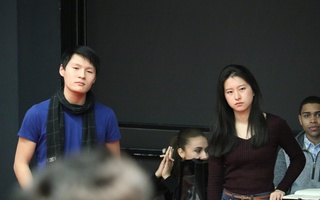Last Thursday, The Crimson reported that members of the Undergraduate Council said the body continues to struggle with a culture dominated by men and characterized by a lack of respect for female and non-binary representatives, 21 years after the election of the first female UC president. Though women were elected UC president in 2016 and 2017, members say institutional barriers persist, pointing to the lack of gender parity in the organization, which had 26 male, 17 female, and one non-binary representatives in 2017.
We are disheartened by the details of the report and revelations about the difficulties women and non-binary members of the UC face in establishing their voices in a majority-male group, but we are not surprised. Many extracurricular organizations at Harvard continue to struggle to increase gender parity and eliminate sexism—even The Crimson. This campus is by no means immune to these barriers to belonging; the vestiges of an antiquated, male-dominated Harvard still exist within many campus groups. We must do everything possible to make individuals of every gender feel at home in their Houses, classes, and clubs at Harvard.
We acknowledge that the UC has been taking action to increase gender parity and change its culture. The UC’s 2010 move to increase outreach to prospective female candidates represented a step in the right direction to ensure women feel included. Women have assumed more leadership roles in the UC this semester than in the past, and a woman has led the Council for the last two calendar years.
However, just because some women have been able to overcome institutional and organizational obstacles does not mean that it has been easy to do so, or that gender equality has been achieved. In fact, as Sruthi Palaniappan ’20 said to The Crimson that women like her have assumed committee chairships in spite of barriers like the unofficial “grooming” process, whereby mostly male chairs select their favorite underclassmen—often male too—to succeed them once they have abdicated their spot.
Thus, it is unclear whether the UC’s efforts have been effective. The Crimson published a similar report about gender inequity in the UC in 2010. The fact that the issue continues to persist in 2018 demonstrates that, at the very least, current efforts have been insufficient in achieving gender equality. Indeed, it shows that more and different action is needed to effectively address the issue.
Although running for a position in a male-dominated organization may feel like an uphill battle for women and non-binary students, we encourage non-male individuals to continue to run for the UC, as this is the most effective way to ensure that the organization’s culture changes. We believe the UC must continue to run outreach initiatives before and during elections to support these candidates as they run and enter the club. We further implore the UC to use all possible avenues to reach a more diverse pool of prospective candidates in an attempt to reverse its persistent gender inequality and at times exclusive organizational culture.
This staff editorial solely represents the majority view of The Crimson Editorial Board. It is the product of discussions at regular Editorial Board meetings. In order to ensure the impartiality of our journalism, Crimson editors who choose to opine and vote at these meetings are not involved in the reporting of articles on similar topics.
Read more in Opinion
A Path Past HateRecommended Articles
-
 After Further Study, Business School Backs Off Pledge to Double Female Protagonists
After Further Study, Business School Backs Off Pledge to Double Female Protagonists -
 'A Sort of Everyday Struggle'
'A Sort of Everyday Struggle' -
Challenging the Housing BinaryAlthough a push for gender-neutral housing is not a recent development, there is still a long way to go.
-
Embracing the SpectrumShattering binary structures isn’t just beneficial for people who live outside of them—although that should be reason enough, as an issue shouldn’t have to benefit the majority in order for it to be deemed worthwhile.
-
 Datamatch to Offer Non-Binary Gender Option
Datamatch to Offer Non-Binary Gender Option













